6. ISLAM AND THE WEST DURING THOSE DARK DAYS

DECLINE ... AND RECOVERY IN THE WEST
CONTENTS
 The Carolingian legacy is carved up – The Carolingian legacy is carved up –
according to Salian law (mid 800s)
 The Holy Roman Empire ... and the The Holy Roman Empire ... and the
Papacy
 The Viking onslaught The Viking onslaught
 French Normans bring Saxon England French Normans bring Saxon England
under feudalism
The textual material on page below is drawn directly from my work
A Moral History of Western Society © 2024, Volume One, pages 216-226.
|
A Timeline of Major Events during this period
1. The Carolingian Empire breaks up / Islam in Spain / Investiture Controversy
814 Charlemagne dies ... bringing his son Louis the Pious to power as emperor
840 Louis dies and his sons now fight over the Carolingian Empire
843 With the Treaty of Verdun, Louis's sons divide up (and
weaken) the Carolingian Empire
Charles
gets the Western portion (future France),
Louis gets the eastern
portion (future Germany)
The "primary" central
portion (Netherlands, Switzerland and Italy) or "Lotharingia"
– and the emperorship – goes to his eldest son Lothair
But Lotharingia will be the least easy to unite and
govern
912 Abd al-Rahman III is able to unify al-Andalus and NW Africa
The region
comes to greatness … even Christian admiration
962 Saxon king Otto I the
Great is awarded the imperial title by the pope
after having
defeated the Magyars (Hungarians) and then taken control in Italy
... ending the reign of successive Carolingians
This now raises the question of how the imperial title is
to be awarded …
and by whom (the "Investiture Controversy"
of the 1000s)
1002 After al-Mansur died (1002) al-Andalus begins a
steady decline
1031 Al-Andalus breaks into a number of competing taifa
and the
Umayyad caliphate comes to an end in Spain
The Spanish Reconquista gathers momentum
El Cid (al Sayid) Rodrigo Diaz de Vivar serves both Muslim
and hristian lords
(second half of the 1000s)
1077 Pope Gregory VII takes the power of investiture against Henry IV
…
forcing him
to submit most humiliatingly at the Castle of
Canossa
1122 Finally with the Concordat of Worms, emperor
Henry V
agrees to leave the appointment
of church officers
to the church ... ending the Investiture Controversy
2. The Vikings (or
"Northmen" … or "Normans")
793 A Viking raid, destruction and slaughter at
Lindisfarne Abbey (northern England)
begins the Northman terror of the coastal
Christian West
835 A second Danish Viking attack takes place ... bringing Danish
settlers to central Saxon
England (the Danelaw) and making such attacks now a regular feature
of English life
840 Carolinian infighting gives the Danes opportunity to
attack France
… even send
longboats up the Seine to burn Paris
876 One of these raiders, Rollo,is able to take control
of Rouen in the heartland of what will
become "Normandy",
Rollo marries a local French aristocrat … at the
same time
working
with
Guthrum in England – becoming a powerful local warlord in the process
878 Wessex king Alfred the Great (871-899) rallies the
Saxons against Guthrum's Danes
(878-880) … Guthrum finally agreeing
to peace
But other Viking attacks continue … keeping Alfred
busy preserving
and uniting
Saxon England – both the North
(Northumbria) and the South
of England
885 The Daneshit France (885) with a huge army … but the
French hold them off at Paris
888 Count Odo (888) becomes King of West Francia … ending
Carolingian rule there
911 West Francia King Charles III decides to accept
Rollo's rule in coastal France
(Normandy) … understanding that
"Duke" Rollo would
then
protect that
strategic eastern coast from further Viking raids.
Thus the "Normans" of Normandy are quickly Romanized (Christianized) – and
brought into Western political-military
service
988 Off in the East, Viking (Rus) leader Vladimir of Kiev
converts to Byzantine Christianity
Vladimir dominates
East Europe
1000 Sweyn Forkbeard is able to regain his position as
Danish king
against the opposition
of the kings of Sweden
and German
Saxony …
1003 Sweyn then take on English king Aethelred
the Unready
for his attacks on Danes
in the Danelaw
(1003-1013) …
1013 Sweyn is so successful that the English recognize him as their king
1014 Sweyn soon dies
1016 Sweyn's son Cnut the Great eventually takes over his father's extensive kingdom
…
including England (1016)
and Norway and southern Sweden (1018-1028)
1035 Cnut dies peacefully ... having assembled a major kingdom
1042
But his huge kingdom is divided into
smaller units, allowing a Saxon of Wessex,
Edward the
Confessor, to become
English king … though Edward was more interested
in piety rather than
power … weakening his 24-year rule (1042-1066)
1066 Edward's place is taken by Saxon Earl Harold Godwinson …
challenged by
Norman Duke
William of Normandy ... who sends a huge fleet to England to
defeat an
exhausted
Harold at the Battle of Hastings ...
bringing England under French
Norman rule (and feudalism)
|
THE CAROLINGIAN
LEGACY IS CARVED UP IN ACCORDANCE WITH SALIAN LAW (mid-800s) |
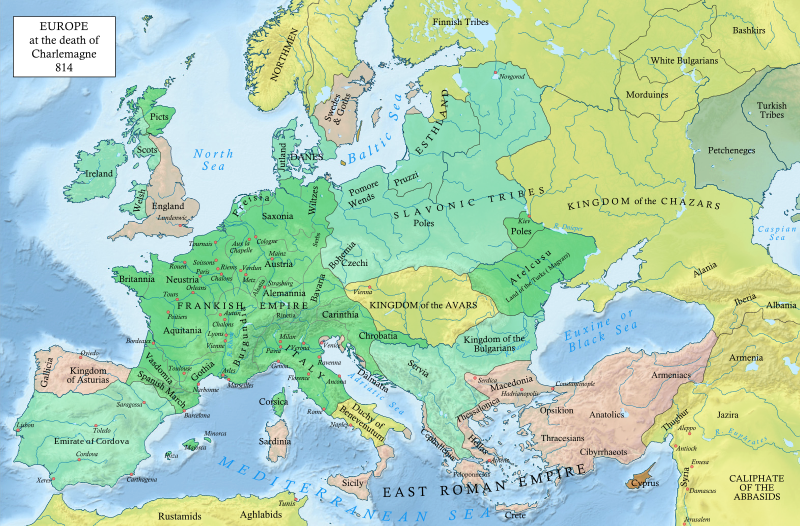
Europe at the time of Charlemagne's death in
814
Wikipedia - "Treaty
of Verdun"
|
Louis the Pious (814-840)
In 813 Charlemagne had his only surviving son Louis the Pious (king of
Aquitaine) elevated to the position of co-emperor with himself ...
shortly before he died at the beginning of 814. Louis had gained
a lot of experience holding the Carolingian line against the rather
rebellious Basques and the expansive Islamic Moors of Spain ... Louis
even led the Carolingian expansion across the Pyrenees in Northeastern
Spain (Catalonia ... or the "Spanish March"). He also was
redirected at one point to fight alongside his father at Beneventum in
Italy.
Nonetheless, Louis grew up understanding that he was to share his
father's empire with his brothers, Charles the Younger, who was
expected to take the emperorship and the heart of the Empire, and
Pepin, who would rule over the Carolingian lands in Italy. But
both brothers died just shortly before their father did (Pepin in 810
and Charles in 811) ... leaving Louis little time to get ready to take
over his father's huge realm.
Upon arriving at Aachen to take over the realm, one of the first things
he did was move swiftly to remove potential sources of challenge to his
rule – relatives mostly, and women was well as men – largely by forcing
them to take monastic orders and sending them to nunneries and
monasteries ... or at least priestly positions within the Church.
But he would still have problems ... not only among independent-minded
dukes but over the question of inheritance among his sons –
particularly after he nearly died in an accident in 817, and decided to
publish a will outlining his inheritance among his three sons.
His oldest son Lothair was to receive the imperial title and the
greatest portion of the Empire. Pepin was assigned Aquitaine and
Louis was assigned Bavaria. Furthermore, in accordance with
Salian law,1 the
children of his own sons were then to receive the right to their
fathers' lands. Supposedly all this then provided for an orderly
transfer of the realm in case of his own death.
That was not to be. It became virtually the declaration of war
among his sons as they maneuvered to improve their inheritance ...
mostly against Lothair and his privileged position in all this.
But in fact the first person to rebel against this assignment was a
nephew Bernard, who realized that he was destined to lose his position
as King of Italy (received from his deceased father Pepin). When
Louis moved his army toward Italy, Bernard surrendered to his uncle ...
only to have himself tried and condemned to death for treason ...
although Louis had the sentence reduced to blinding – which nonetheless
caused Bernard to die from his wounds a few days later.
Subsequently (822), Louis became extremely penitent for his actions
against his nephew and appeared before the Pope and a gathering of
bishops and noblemen to repent of this great sin. His penitence
included the release of noblemen sent to monasteries ... sources of
future problems. The act of "piety" also made him appear merely
weak in the eyes of his people.
In 820 he remarried after the death of his wife two years earlier ... and soon (823) had a fourth son, Charles,
from this marriage. He thus revised his will, granting Alemannia
to Charles in 829 ... taking it from Lothair's inheritance. At
this point his empire fell into civil war, the brothers, joined by
other political and ecclesiastical (Church) figures, maneuvering to
improve their positions in this scramble for position in the
empire. When Louis promised greater portions of the empire to his
sons Louis and Pepin (also taken from Lothair's designated portion) the
brothers then joined him against Lothair ... and Louis was finally able
to end the rebellion (830).
But the "peace" was shaky ... and war broke out again in 832 ... with
Louis reassigning lands in an attempt to control the conflict – merely
making things worse for himself. He was finally defeated by his son
Lothair (833) ... and forced again to do penance when Louis was
abandoned by his supporters. He thus also was forced to give up
his throne. But Louis's humiliation brought out his supporters in
force, and the next year (834) Lothair was forced to step aside to let
his father resume his throne. Lothair ended up losing all but
Italy as his realm ... but the family finally was reconciled (836) ...
just in time to meet a new problem: Viking attacks coming from the
North (beginning in 837). Louis was quick to construct a new navy
... to protect Frankish interests in the North Sea.
Another effort by Louis to reapportion the inheritance of his realm in
837 brought forth yet another or "third civil war." Louis's
massive increase in Charles's inheritance once again sparked rebellion
among Charles's brothers (and opened the way for more Viking
mischief). This time, with Lothair's help, Louis was able to put
down the rebellion (840) ... not that Louis was able to long enjoy the
fruits of his victory, for he died that same year.
The Treaty of Verdun (843) dividing the empire
With their father dead, the three surviving brothers – Lothair, Charles,2
and Louis (Pepin had died in 838) – once again turned on each
other. Lothair claimed the entire inheritance ... minus
Aquitaine, which he assigned to his nephew Pepin II. But neither
Charles nor Louis acknowledged Lothair's claim and war broke out again
among the brothers. In 841 Charles and Louis defeated Lothair at
the Battle of Fontenay ... and the following year (842) they were so
bold as to declare Lothair unfit as emperor. At this point
Lothair was willing to yield to negotiations held at Verdun.
The results of the negotiations were that Louis was awarded
sections of the Empire East of the Rhine River, Charles the Western
sections of the Empire, and Lothair a central strip of land – one
reaching from the Netherlands in the North, then south along the
Western bank of the Rhine ("Lotharingia" or "Lorraine"), then
Burgundy and Italy in the South … plus the right to keep his imperial
title.
Whereas Lothair's territory lacked any centralizing tendency (plus
having the grand impediment of the Swiss Alps positioned in the
middle), Louis was able to take control of a land that would remain
culturally largely "German" (thus his title, "Louis the German').
At the same time Charles's more Latin-based Western territory would
become the foundation for the country of France.
This division would weaken greatly the peace, stability and prosperity
of the Carolingian Empire ... gradually driving Northern Europe back
into something of another "Dark Age" ... especially with the Vikings
taking advantage tremendously of the disunited and thus greatly
weakened Empire.
1On
the other hand, in England the Saxons practiced primogeniture, in which
the oldest son inherited all of the father’s lands. That
certainly was viewed as unfair by the other sons ... but it kept the
work and thus inheritance of the father intact from one generation to
the next. The Salian law of the Franks was "fairer" to the sons
... but left the father’s legacy greatly weakened when it was divided
fairly equally among his sons. However, the Franks eventually
were forced to adopt primogeniture as the only serious solution to the
problems caused by a constant dividing of the family’s feudal
inheritance.
2He would
eventually come to be known as Karolus Calvus, Charles the Bald ...
although it had nothing to do with his hair ... of which he always had
plenty! Speculation today is that instead it was in reference to
the fact that at one time he was a son without any holding of
land. But no one knows for sure why the title.
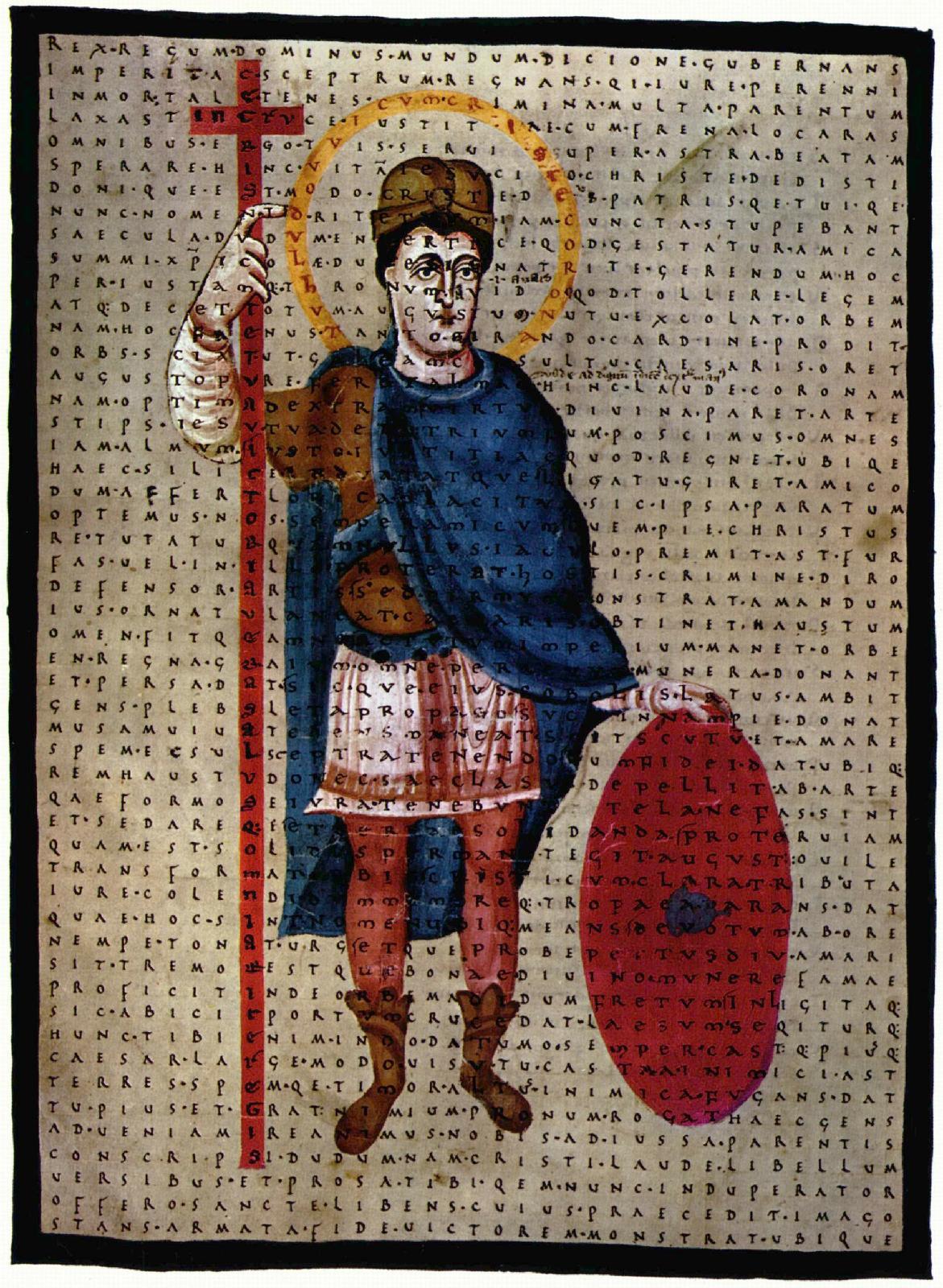 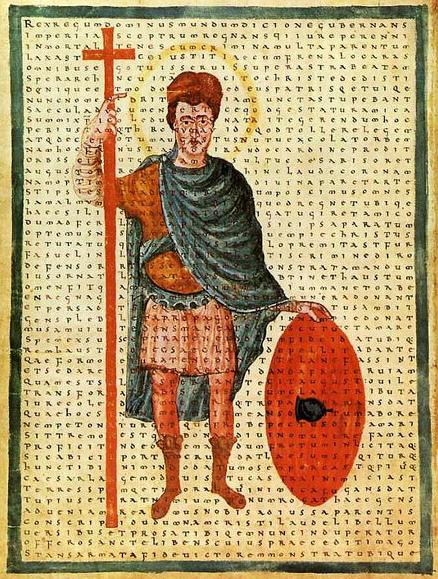 Louis the Pious -
Charlemagne's
son and successor - ruled: 814-840 ... contemporary depictions from 826
as a miles Christi (soldier of Christ) with a poem of Rabanus Maurus
overlaid
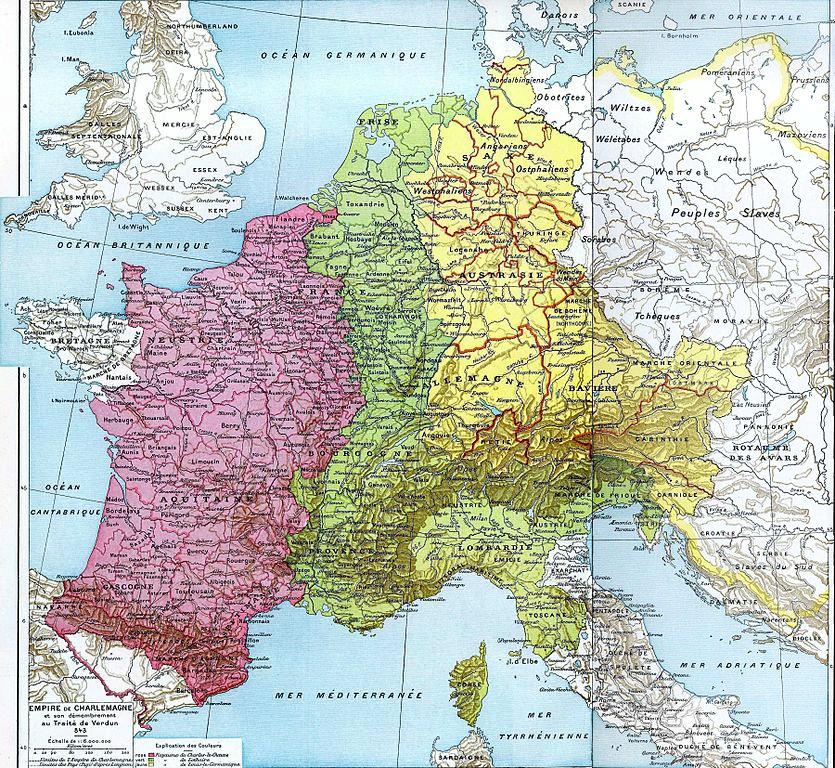
The three-part division of
Charlemagne's Empire in the 843 Treaty of
Verdun
Wikipedia - "Treaty of
Verdun"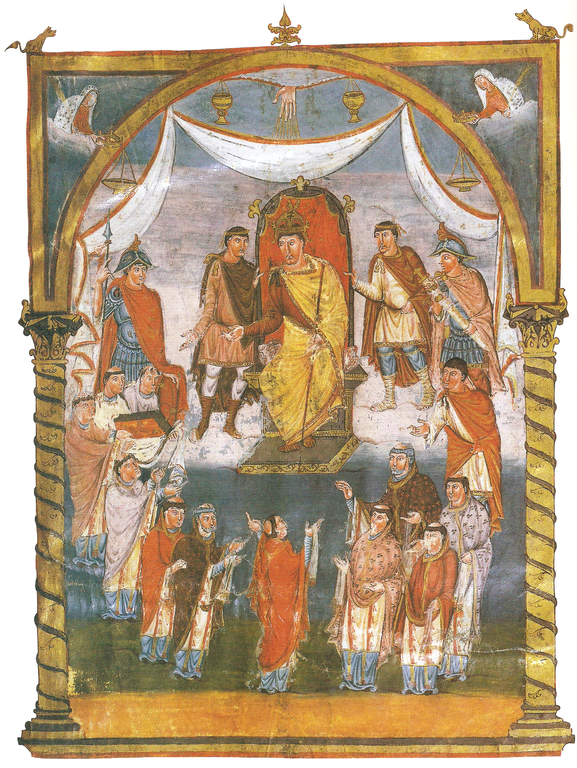
Charles the Bald (grandson
of Charlemagne) - King of France - 843-877. An illustration in the First
or "Vivian' Bible of Charles the Bald, painted ca. 845-851 (the Bible was the
sole surviving manuscript of a Viking raid in 853)
Paris - Bibliothèque Nationale
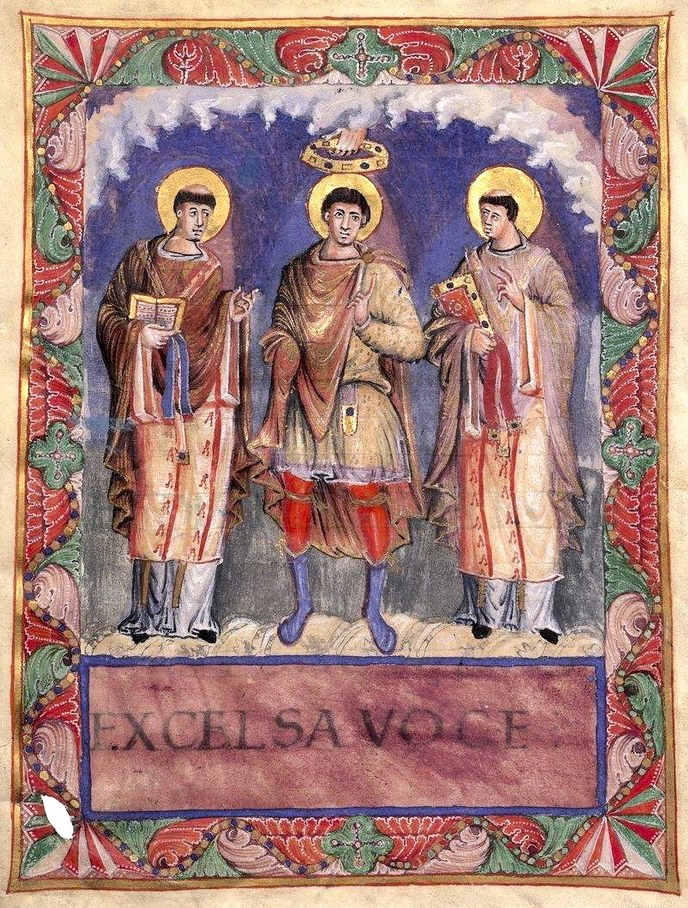
Charles the Bald with
Popes Gelasisus I and Gregory I – from the sacramentary
of Charles the Bald (ca. 870)
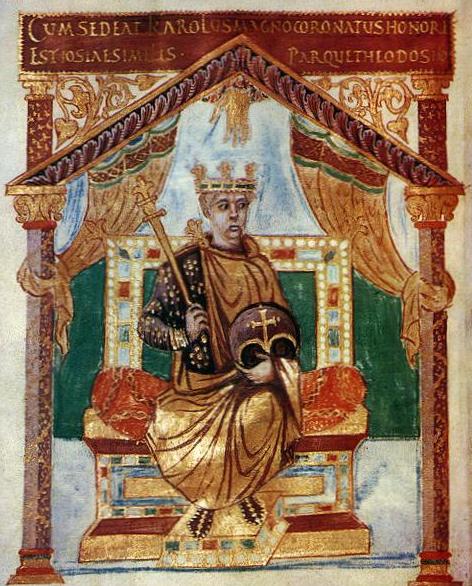 Charles the Bald
enthroned - King of France
Paris, Bibliothèque Nationale
THE HOLY ROMAN EMPIRE ... AND THE PAPACY |
|
The loss ... and then the restoration of the imperial title
The imperial title was passed through future generations of the
Carolingian dynasty ... then placed under challenge by Vikings from the
north and then a mass of dynastic contests, enfeebling the dynasty
greatly. The imperial title got lost, was restored again, then
just passed out of existence as the Carolingians lost their political
positions in most places.
Then the Italian King Berengar came forward to claim the imperial title
finally in 915 ... holding onto that claim until his death in
924. Then the title fell into disuse.
Otto I the Great
In 962 Saxon3 King Otto I – who had succeeded in bringing a number of
German duchies under his rule, who then in 955 decisively defeated
invading Magyars (Hungarians) from the east, and who then in 961
absorbed the Kingdom of Italy – was crowned in Rome as Roman Emperor4 by
Pope John XII.
This Germanic central European (and northern Italian) imperial state –
the "Holy Roman Empire" – would remain intact through many centuries –
in fact all the way up to 1806, when the French Emperor Napoleon
formally put an end to the title and position.
The elective nature of the imperial position
At first the title was hereditary, with a series of Ottos (II and III)
and a cousin Henry inheriting the position and title after Otto
I. But with Henry's death in 1024 the position became elective
among a group of prominent dukes and other noblemen – constituting a
College of Electors. Dynasties would subsequently come and go in
the imperial position ... but because of the ultimately elective nature
of the office the Emperor would seldom enjoy full power.
3The continental Saxony located in the German Southeast ... not the Saxony established in Britain.
4The formal imperial title would become that of "Holy Roman Emperor" by the 1200s.
|
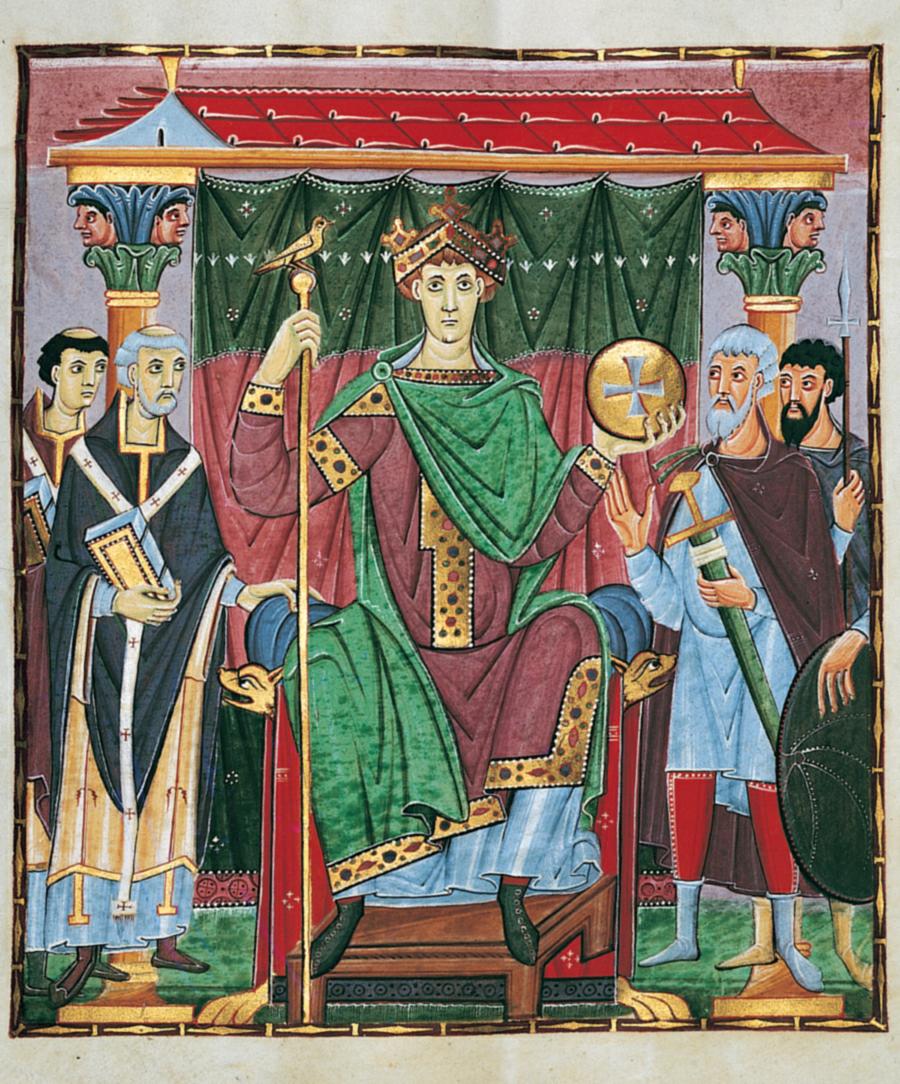
Otto III from the Gospels
of Otto III (reigned 996-1002)
Munich, Bayerische
Staatsbibliothek
|
The Investiture Controversy
At the same time, the rise of emperors, kings and dukes under the new
"imperial" (and feudal) system now posed a new problem for Western
society. The working relationship between the secular rulers
(dukes, kings and emperors) with their military power and the Church
with its absolute religious authority left unanswered the question that
would dog the Western political system for centuries: of the two, who
had the greater authority, the secular or the religious leaders of
Europe?
This question centered particularly on the question of naming local
bishops (the process of investiture), where kings and dukes wanted to
name members of their own families (upper-level church officials were
almost always drawn from the aristocratic class) to the cathedrals
located in their feudal districts ... as well the Popes and archbishops
who felt that this was strictly the Church's prerogative.
Compromise usually worked. But sometimes not. And the
stress on medieval Christendom would become murderous when a deadlock
over the matter occurred.
Emperor Henry IV and Pope Gregory VII
A
particularly famous blowup occurred between the German King (and
subsequently Holy Roman Emperor) Henry IV and the Roman Church and its
officials, particularly Pope Gregory VII. In 1059, Church
reformers moved swiftly during Henry's infancy to take the appointment
of the Roman bishop (Pope) out of imperial hands and place that
responsibility fully in the hands of a newly created College of
Cardinals made up solely of church officials. Then in 1075, a new
pope, Gregory VII, went even further to declare that the appointment of
the Emperor could be done only by the Pope. But at this point
Henry was an adult ... and fought back and proceeded to appoint his own
bishops ... and even called for the election of a new pope (which Henry
fully expected to control).
Henry's humiliation
Pope Gregory retaliated by excommunicating the emperor. Jealous
German princes were more than happy to see Henry thus humiliated ...
and defeated his army and seized the imperial lands for
themselves. At this point (1077) Henry had no recourse but to
make amends with Gregory ... and went before the pope at the castle of
Canossa in the dead of winter, barefoot and wearing the penitent's
hair-shirt.
|
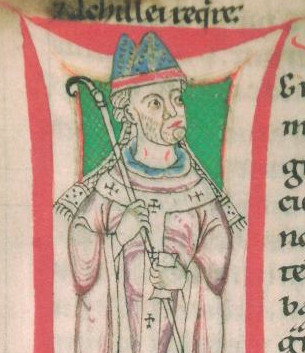
Pope Gregory VII
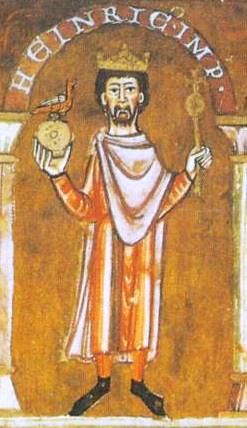
Emperor
Henry IV
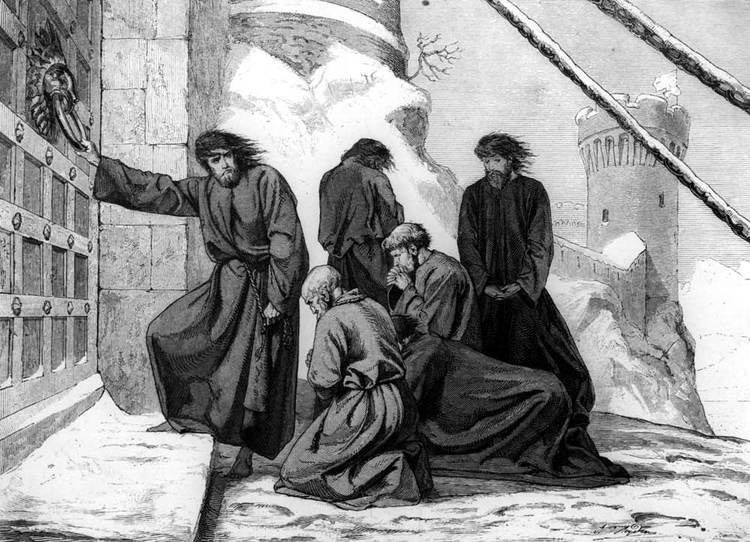
Henry at the Gate of Canossa - August von Weyden (1882)
Gregory
ultimately forgave Henry ... but the princes did not. They elected a
rival, Rudolf, to Henry's place as emperor ... and Gregory then also
moved his support to Rudolf and once again excommunicated Henry.
Henry then proclaimed Clement III to be the pope and moved on Rome with
his army ... only to be faced by Normans called out by Gregory to
support him.
But the Normans instead sacked Rome ... causing the Roman citizens to
rise up in revolt against Gregory and his Normans ... who were then
forced to flee. Gregory, however, died soon after. But the controversy
continued.
The Concordat of Worms
Then in 1106 Henry's son, Henry V, supporting the papal party, took
over his father's throne ... but then he too appointed his own
candidate Gregory VIII as pope, starting the whole investiture
controversy up again. However eventually (after much back and forth
struggle between the emperor and various popes and anti-popes), with
the signing of the Concordat of Worms in 1122, Henry V abandoned his
papal candidate and agreed to end the emperor's right of investiture of
church officers.
But this would not end the issue ... for it would spread elsewhere
(England for example) and be a constantly troubling issue involving the
relationship between church and state in Christian Europe.
|
The
sacking, burning (of its immense library) and slaughter in 793 of the
wealthy and famous monastery and its monks at Lindisfarne (coastal
Northeast Britain) was the announcement that a new, crude, and
extremely violent set of players had emerged out onto the European
political stage. The Vikings had finally made their appearance
... and would terrorize Europe for the next several centuries.
Behind this activity were factors similar to the Germanic incursions
into the Roman Empire: land hunger. The population of
Scandinavia had been expanding in a land that is mountainous and cold
... and thus not well suited to bringing new lands under cultivation to
feed a growing population.
In their forays out of the North, they were determined and focused ...
and learned quickly how defenseless the Christians to the South of them
were to unexpected surprise attacks coming from these warriors in their
longboats. These longboats were an amazing piece of naval
technology, one that allowed them to go most anywhere on the high seas,
yet move deeply upriver along any of the European tributaries to those
high seas.
They ventured far and wide, settling Iceland and reaching North
America in the West ... in the East venturing deep into the Slavic
lands of what would eventually (under their domination) become Russia
... and in the South venturing into the Mediterranean and even
establishing Viking or Northmen (simplified to "Norman")
settlements on the strategic island of Sicily.
The Vikings in England
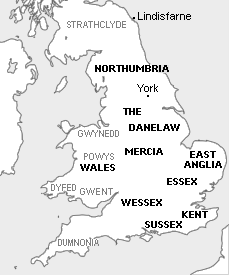 For the next 40 years following the sack of the abbey at Lindisfarne
little would be heard from these Nordic marauders ... until around 835
when Viking raids resumed ... and became a regular feature of English
life.
For the next 40 years following the sack of the abbey at Lindisfarne
little would be heard from these Nordic marauders ... until around 835
when Viking raids resumed ... and became a regular feature of English
life.
By the 860s raids had become complete invasions by Danish Viking armies
accompanied by Danish settlers (the "Great Heathen Army"). One by
one (865-875) the Saxon kingdoms fell before the Danish invaders ...
until Wessex, the western portion of Mercia and the northern portion of
Northumbria remained as the only Saxon kingdoms still intact. In
the middle of what had once been the Saxon heartland, the Danish
established a Viking state operating under Danish custom ... eventually
known as the Danelaw.
Alfred the Great (r. 871-899)
Alfred was the fourth in a line of brothers to come to rule Wessex
("West Saxony") after their father, Aethelwulf died in 858. He
fought alongside his older brother Aethelred against the Vikings in a
series of battles that varied between Saxon victories and Viking
victories. Then when his brother died in 871, Alfred found
himself at age 23 as the new leader of Wessex.
But things got off to a bad start for Alfred ... even though he was
able to get the Danes to leave Wessex ... probably at some great cost
in tribute. For the next five years the situation stabilized
around this arrangement.
Then in 876 the Danes came under an ambitious leader, Guthrum, who
disregarded truces and agreements in the attempt to spread his personal
rule deeper into Saxon England. Alfred fought back fiercely ...
but in January of 878 he barely escaped with a small group of followers
when Guthrum suddenly attacked and slaughtered the inhabitants of a
town where Alfred had been staying for Christmas. At this point Alfred
went into hiding.
In May of that year he emerged to rally again a Saxon army ... and then
at the Battle of Edington was able to deliver the Danes such a blow
that they retreated to a position that Alfred then encircled ... and
slowly pushed the defending Danes to a point of starvation.
Guthrum's Danes surrendered ... and as part of the terms of surrender
had Guthrum and his court baptized.
Eventually (880?) a treaty was agreed on between Alfred and Guthrum,
respecting Alfred's sovereignty over Wessex and the western part of
Mercia with Guthrum acknowledged as ruler of East Anglia and the
eastern portion of Mercia ... the foundation of the Danelaw
.
This did not end the Viking threat ... for not all Vikings were in
agreement with this arrangement – and a number of them crossed to the
European continent to raid and sack towns there. Also independent
Viking bands continued to descend from Denmark to raid the shores of
England ... although they presented themselves more as a bloody
nuisance than as a serious political threat – except for one Danish
attack in Kent (885) which weakened but did not undo Alfred's position
there.
But with Guthrum's death in 889 the Saxon-Dane truce began to
disintegrate as local Danish warlords went to battle to claim
ascendancy in Guthrum's place.
Then in 892 (or 893) a large fleet of Danes crossed from the European
continent to invade Kent ... with the obvious intent of seizing and
settling the land there. As Alfred was confronting this group of
Danes, others arrived at other parts of England, requiring Alfred to
keep his troops constantly on the move ... forcing the Danes back here
and there (the Danes, being mostly raiders rather than settlers, and
thus lacking their own food and supplies, were not prepared for long
encounters).
And thus he busied himself protecting (rather successfully) his domain
... reclaiming even much of what the Vikings had taken from the Saxons
– including the strategic city of the north, York. For this he
was well-beloved by his people ... some who considered him to be
virtually a saint!
Alfred was remembered not only for his fighting skills but also for
building the a small but effective navy, for his hard work at
organizing his Saxon domain into effective political units, structured
by a law code of his own making, and for his efforts to raise the level
of learning within his kingdom (abysmally low given the damage the
Vikings had done to the monasteries which had long served as England's
educational centers). Of particular importance was his effort to
promote such educational improvement in terms of the English language
rather than the usual Latin.
He died in 899, having given Saxon England a relative degree of peace
in the face of the constant Viking threat ... a threat that was still
making life in coastal Europe miserable.
The Vikings in France
Charlemagne's feuding grandsons gave the Danes next door to the north
the opportunity in the 830s and 840s to conduct raids of Frankish
coastal cities (while they were doing the same across the channel in
Saxon England). In 850 a huge Viking raiding party (5,000 men)
under Ragnar sailed all the way up the Seine River to attack the
strategic city of Paris ... sacking and slaughtering in the
process. Only a major plague – and Carolingian King Charles the
Bald's payment of 7000 livres (pounds) of silver and gold, and the
promise of continuing payments after that (eventually termed the
Danegeld) cause the Danes to leave.
Vikings would return again and again ... but encountering much more secure town walls guarding Paris.
Then in 885 the Danes returned with hundreds of ships and tens of
thousands of warriors to attack Paris but even then found the
Parisians, led by Count Odo, able to hold out against this massive
onslaught. Months went by (Vikings venturing from there to sack
and plunder in the region). Only the next summer did the
Carolingian King Charles the Fat arrive ... not to fight the Vikings
but to let them continue upriver to attack the rebellious Burgundians,
and to offer a huge payment in silver. This was hardly a
satisfactory solution to the Parisians ... and when in 888 Charles
died, the stronger Odo was elected King of West Francia – the first
non-Carolingian to take that title.
Also of note was the last Viking leader to vacate the siege of Paris
was Rollo ... who would come to play a huge part in the rise of these
Vikings or "Northmen" (or "Normans") in France.
Rollo
Rollo in 876 had already taken control of the city of Rouen (downriver
from Paris) and the coastal city of Bayeux probably prior to even that
... where he captured, married and had a son, William, by the daughter
of the local Frankish count. He also seems to have had some kind
of working relationship with Guthrum, the Danish king of East Anglia
across the channel. In short, Rollo was busy establishing himself
as something of a local lord in northwestern coastal Francia.
In 911 French king Charles III of West Francia (France) finally came up
with the brilliant idea of negotiating a deal with Viking leader Rollo
after he and his Vikings had burned and sacked Paris (again). He
gave formal recognition by Rollo and his Norman warriors and their
families (after being baptized) of the ducal rule (under the
sovereignty of the king himself, however) of the region at the mouth of
the Seine River (eventually "Normandy"), understanding that with a
vested interest in the peace of the region, Viking military prowess
would be the best way of keeping Paris from being regularly sacked and
burned by future Viking predators. It worked. And
eventually the Norman Vikings were assimilated into French culture.
|
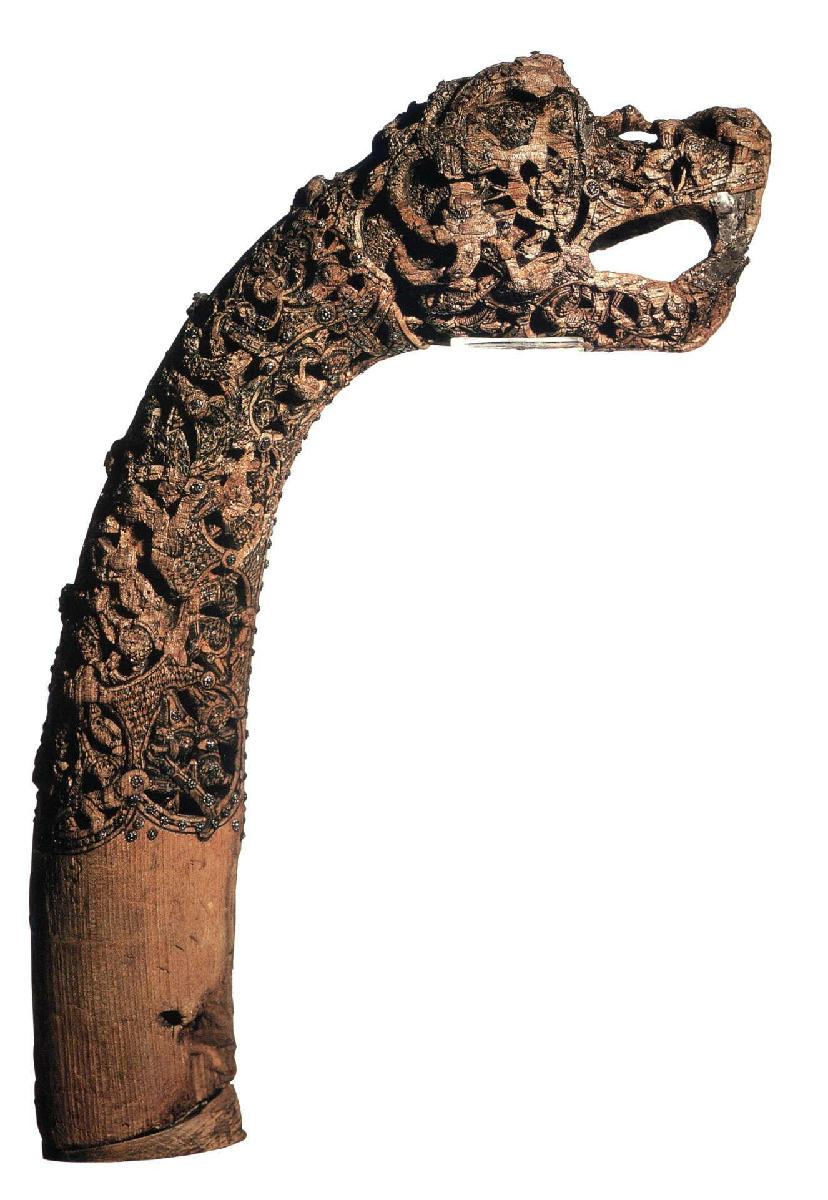
Grip of a Viking processional
cudgel (800s)
Oslo, Universitets
Oldsaksamling
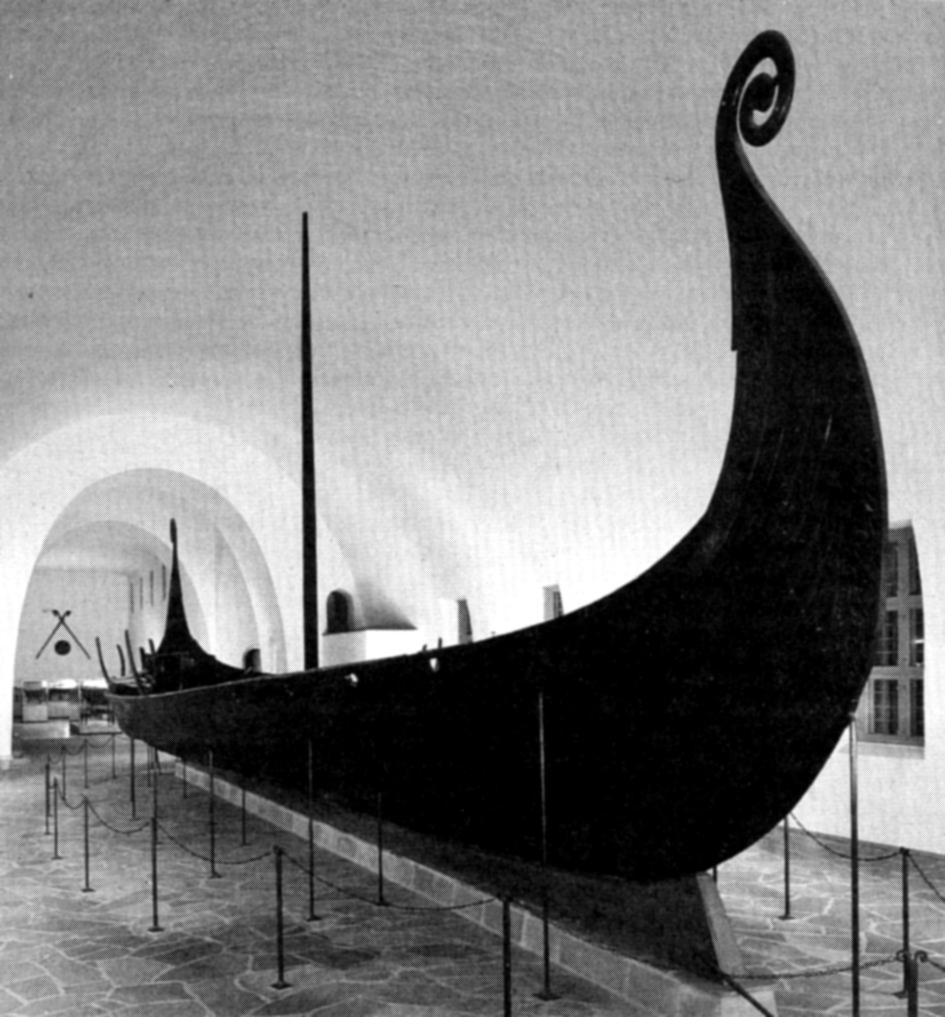
A finely constructed Viking ship
used for the burial of possibly a king
FRENCH NORMANS
BRING SAXON ENGLAND UNDER FEUDALISM |
|
Continuing Viking attacks on England
Viking raids on England never really ceased. But it was not until
947 that they were truly threatening to the Saxon kingdom – for in that
year Erik Bloodaxe was able to take York and add it and the region of
Northumbria to his Norwegian kingdom. But actually this was only
part of the ongoing relationship (peaceful and warlike) that united the
destinies of England and Scandinavia.
Sweyn Forkbeard
Another challenge to Saxon England began to brew in the mid-980s when
Sweyn Forkbeard seized the Danish throne from his father Harald
Bluetooth ... but was driven into exile for the next fourteen years by
his father's allies (including the kings of Sweden and German
Saxony). But by the year 1000 Sweyn rebuilt his power base ...
and then led a series of attacks on England – off and on between the
period 1003 and 1013 – in retaliation for Saxon king Aethelred the
Unready's savage attacks on Danes living in the Danelaw. Sweyn
was so successful that even the Saxons of England were ready to
acknowledge him as the King of England in late 1013.
Cnut the Great takes the English throne
But Sweyn died only a few weeks later in early 1014. At this
point his sons took over, Harald in Denmark and Cnut in England ...
although it took a long struggle against Aethelred's son Edmund
Ironside for Cnut to achieve this position (finally in 1016). In
1017 the Saxon Archbishop of Canterbury officially crowned Cnut as King
of England. To further secure this throne Cnut had most of the
Saxon nobility and the sons of Aethelred executed – but married
Aethelred's widow, Emma ... eventually elevating as royal heir his son
by her, Harthacnut, above his sons by his first (Danish) wife. He
extracted a huge indemnity from the English in order to pay off his
troops – most of whom he then dismissed – but retained a large navy
(presumably to protect his kingdom from other Viking invaders).
He reorganized the lay of his kingdom into a group of four earldoms,
appointing key supporters to each as Earl ... some of these earls
eventually drawn from the ranks of noble Saxons.
When his brother Harald died soon thereafter (1018) Cnut then moved to
take the position as King of Denmark (converting it into another of his
earldoms). But his greatest work was in the way he united the
English Saxons and Vikings of the Danelaw into a single society ...
joined together in a military expedition into the Baltic and then to
Norway, where he took position there as King of Norway (including part
of southern Sweden).
By 1026 Cnut was the ruler of a vast kingdom. And so well established
was he that he dared to take a trip (or pilgrimage) all the way to Rome
in 1027, to attend the coronation of Conrad as Holy Roman Emperor ...
indicating Cnut's own rank among the Christian "greats" of his day.
But aside from the successful challenge to his rule in Norway by
Norwegian nobility Cnut's rule was quite stable until the year of his
death in 1035.
The Norman conquest of England
Edward the Confessor (r. 1042-1066).
But that stability was not to last long. Upon his death his huge
kingdom was divided up into a number of smaller kingdoms … with his
descendants fighting among themselves for supremacy. Ultimately
in England, actually a Saxon nobleman of the House of Wessex, Edward
"the Confessor" was able peacefully to take the position as England's
new king. However, Edward seemed more interested in piety than in
political power … thus the name "the Confessor." This tended to
weaken greatly the 24-year rule of Edward … to the advantage of local
Saxon lords. This proved to be especially the case for the house
of Godwin … earls of the powerful Wessex domain.
Harold Godwinson – the last Anglo-Saxon king (1066).
Then as death approached, Edward named the well-proven warrior Harold
Godwinson, Earl of Wessex, to be his successor. But the
Norman-French Duke William of Normandy then claimed that earlier, on a
trip to the continent, Harold had sworn fealty to William – in support
of William's claim to the English throne. Supposedly also, the
childless Edward the Confessor had earlier named his cousin William to
be his heir in England.
So then, who had actually the right to the English throne upon Edward's
death? Ultimately, the contest between Harold and William for
this position would prove to be deeply life-changing for English
society.
The Battle of Hastings (October 1066).
At the time, Harold was engaged in a fierce conflict with his brother
Tostig … while over in France, William was assembling a huge navy (700
ships), ready to convey a massive army across to England and seize
control (and the throne) there. Furthermore, Pope Alexander
II took the side of William, claiming that he did so because Harold had
broken his earlier oath to William. Hearing this, other English
noblemen also took William's side. Things were not looking good
for Harold.
Then things got much worse in mid-September, when Norwegian king Harald
Hardrada – joined by Harold's brother Tostig – invaded Northumbria and
defeated the English earls there. This forced Harold to have to
move his troops quickly to the north … where the invading troops were
defeated and Hardrada and Tostig were killed (late September).
But at the same time, William of Normandy's huge navy and army arrived
at England’s southern shores in East Sussex. Thus Harald had to
quickly force-march his army 240 miles back to the south. Then on
14 October the two sides went to battle. The Saxon lines held
over the course of most of the day. And then a retreat by the
Normans Harold interpreted as the path to victory … only to find that
his army had just marched into a trap. Harold was then killed …
and the Saxon effort fell apart. It was a huge victory for the
Normans.
The larger outcome.
This, of course, established a Norman-French feudal rule over the
English-speaking Saxon commoners. By doing so, it established a
strict class-based society, with French-speaking Norman families now
ruling over the English-speaking Saxon commoners … and with a class
barrier erected between the two groups that was almost totally
unbridgeable. And it would be lasting.
However also, with this event, Britain was now finally closely linked to continental European affairs.
|
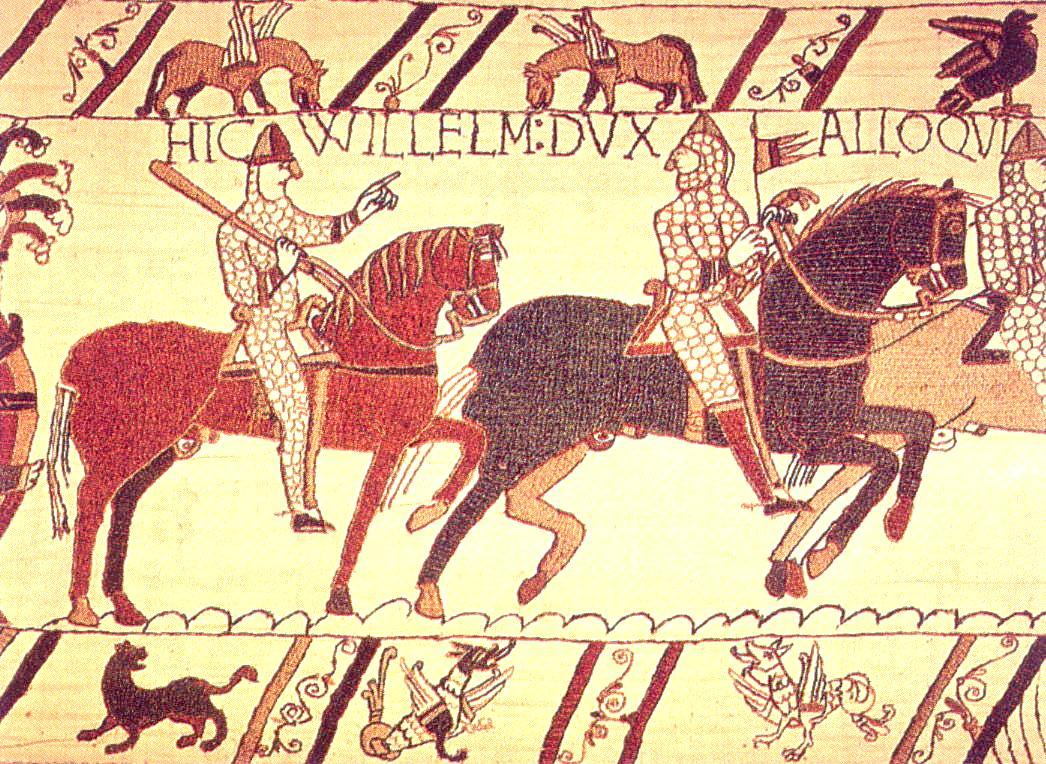
Detail from the Bayeux tapestry
– William, Duke of Normandy, haranguing his troops (1070 - 1080)
Bayeux, Musée de
la Tapisserie

 Miles
H. Hodges Miles
H. Hodges
| |


 The Carolingian legacy is carved up –
The Carolingian legacy is carved up – The Holy Roman Empire ... and the
The Holy Roman Empire ... and the French Normans bring Saxon England
French Normans bring Saxon England
















